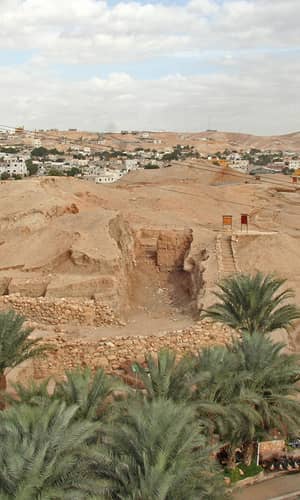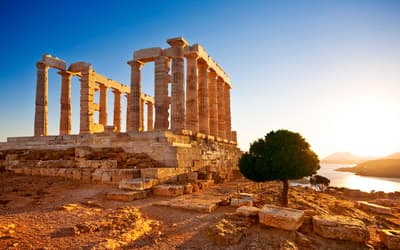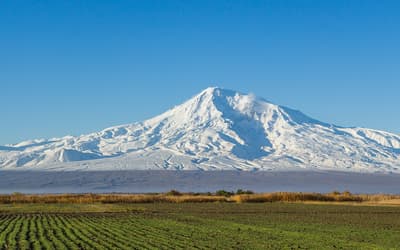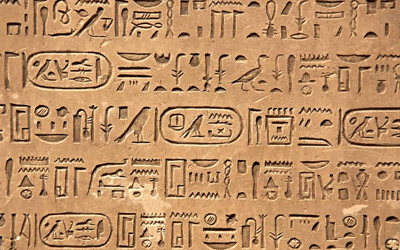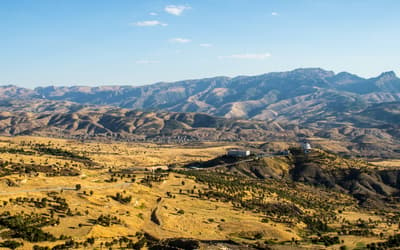The views expressed in this paper are those of the writer(s) and are not necessarily those of the ARJ Editor or Answers in Genesis.
Abstract
In this paper I push back against Osgood’s claims about dating the Hiel wall, and defend which wall was built by Hiel. In addition, I show that Eglon, king of Moab, was irrelevant to the history of Jericho’s walls, and Osgood’s claim that he lived in Jericho is unsupported by the biblical narrative.
Keywords: Jericho, Early Bronze, Middle Bronze, Hiel the Bethelite, Eglon King of Moab
Introduction
Osgood’s approval of the destruction of Joshua’s Walls of Jericho at the end of the Early Bronze IIIB is gratifying, as this sets the time frame for the walls in the rest of my paper (Habermehl 2024). However, he makes further comments that require answers because of errors in his arguments.
Dating of Hiel’s Wall
Osgood clearly has the different systems of archaeological dates confused (Osgood 2024). The dynasties of Egypt have nothing to do with my paper on the Walls of Jericho, as I clearly state (Habermehl 2024). And the Eighteenth Dynasty does not correlate with the Late Bronze Age, as Osgood incorrectly states. When we try to synchronize the dynasties of Egypt with the Bronze Age, we get into trouble in a hurry, as I discovered when writing that paper. These dual systems of dating (Bronze Age and Egyptian dynasties) are admittedly not simple to understand. But we must get them straight when we use Bronze Age dating.
My Jericho Walls paper is built on the Bronze Age system of dating, because that is what all archaeological work on Jericho and Canaan is based on. If we are going to say that Joshua’s wall fell at the end of the Early Bronze IIIB, we cannot say that the Exodus took place at the end of the Eighteenth Dynasty. We have to say that the Exodus occurred near the end of the EB IIIB (allowing for the 40 years between the Exodus and the conquest).
In fact, the end of the EB IIIB is considered by archaeologists to be approximately at the end of the Sixth Dynasty. Standard dating of the Sixth Dynasty is 2345–2181 B.C. (see Sixth Dynasty of Egypt 2024). For the dates of the Early Bronze, see Bronze Age (2024); the end of the Early Bronze IIIB in the Near East was about 2200 B.C. (Note that the divisions of the Bronze Age can vary somewhat from one source to another).
In my paper synchronizing the Egyptian timeline with the biblical timeline (Habermehl 2023), I run the Sixth and Twelfth Dynasties parallel, with the Exodus taking place at the end of both Dynasties. This is because of the collapse of Egypt that took place at the end of both of those two dynasties—collapses that had to have been caused by the ten plagues of the Exodus. Historians do not seem to have realized how odd it is that Egypt collapsed twice in the same way by the same factors.
As I said in my paper on the Walls of Jericho, archaeology shows that there was a mudbrick wall built in Jericho at just about the right time (around 500 years) after the original conquest (Nigro 2006). This is about the biblical time that elapsed between the Conquest and the time of Ahab’s reign, when Hiel built it (Jones 2005, 279). Archaeologists have found no other walls built between Joshua’s wall and this mudbrick wall. It is, as they say, a slam dunk! Simple logic says that this mudbrick wall has to be Hiel’s wall.
I note here that, ultimately, our conclusions have to be based on what occurrences or objects fit the biblical narrative. This is why we are putting Joshua’s wall at the end of EB IIIB, and it is why the mudbrick wall has to be that of Hiel. If we grab the standard secular timeline and run with it to draw conclusions, we can land in the mire easily. This is essentially what Osgood does with his claim that Hiel’s wall should be dated to the Eighteenth Dynasty.
The City of Jericho: Foundation and Gates
Osgood is quite correct that I said that Hiel did not build the city of Jericho, but only a wall. It is exactly what I meant. The biblical words, “In those days Hiel the Bethelite built Jericho” mean what the Bible says they mean ( 1 Kings 16:34). This verse goes on to say that the foundation and gates were laid, and that his two sons died during the project, as prophesied by Joshua (Joshua 6:26). What Osgood has done is reinterpret what he thinks those words should mean, although the Bible has already clarified this.
There is nothing that says that Hiel built all the houses that were already on the site of the tell at the time. The archaeological history of the Jericho tell shows that after Joshua’s destruction in EB IIIB there was gradual occupation of the site over the next 500 or so years. Finally, Hiel built his wall around it and set up its gates. That made it a city (Montanari 2019; Wright 1904).
It is doubtful that Hiel sacrificed and buried his sons, as Osgood claims. The Bible does not say so, and if Hiel had done this, we might wonder why an action like this would be called a curse. It is more likely that his sons died in construction-related accidents. In Joshua 6:26 the LXX (NETS) adds: “And thus did Ozan of Baithel: at the cost of Abiron, his firstborn, he founded it, and at the cost of his youngest, although he escaped, he set up its gates.”1 The clause “although he escaped” would appear to indicate that Hiel nearly died as well as his youngest son in an accident.
Eglon
There is nothing in the biblical story about Eglon (Judges 3: 12–30) that says that he was in Jericho when Ehud killed him. Where does Osgood get this idea? The Bible says that Eglon, king of Moab, came up and smote Israel and possessed Jericho, the city of palm trees (Judges 3:13). This was over 400 years before Hiel built his wall (Jones 2005, 278–279). Nothing is said about Eglon building anything in Jericho or living there. Eighteen years later the Israelites sent a present by the hand of Ehud to Eglon. There is no location indicated where Eglon was at that time, except that he was in a “summer parlour” (Judges 3:20).2 It would seem logical that Eglon would have been in his own palace somewhere in Moab, a country that was adjacent to Israel, especially since the Bible does not tell us anything else. I also note that Jericho would be a really strange place for a king to have a summer house to keep cool, as the temperatures there in summer run as high as 100°F (see Jericho 2024).
Even if Eglon had built anything on the Jericho tell at any time, it would be totally irrelevant here. It is difficult to understand why Osgood raises the subject of Eglon at all to prove anything.
Conclusion
Osgood’s criticisms on the dating of Hiel’s wall and the meaning of the building of Jericho are invalid. Eglon of Moab does not enter discussion of the walls of Jericho in any way as there is no evidence that he ever lived there. Even if he had done so, it would have been long before Hiel built the wall.
References
Bronze Age. 2024. Wikipedia. https://en.wikipedia.org/wiki/Bronze_Age.
Habermehl, Anne. 2023. “Synchronization of the Biblical and Egyptian Timelines.” Answers Research Journal 16 (November 8): 561–576. https://answersresearchjournal.org/ancient-egypt/synchronization-biblical-and-egyptian-timelines/.
Habermehl, Anne. 2024. “The Walls of Jericho: Dating Joshua’s Conquest of Canaan.” Answers Research Journal 17 (January 10): 1–8. "https://answersresearchjournal.org/archaeology/jericho-dating-joshuas-conquest-of-canaan/.
Jericho. 2024. Wikipedia. https://en.wikipedia.org/wiki/Jericho.
Jones, Floyd Nolen. 2005. The Chronology of the Old Testament, 16th ed. Green Forest, Arkansas: Master Books.
Montanari, Daria. 2019. “Tell Es-Sultan/Ancient Jericho in the Early Bronze Age IV: A Summary.” Rosapat 13: 135–153.
Nigro, Lorenzo. 2006. “Results of the Italian-Palestinian Expedition to Tell es-Sultan: At the Dawn of Urbanization in Palestine.” In Tell-es-Sultan─Jericho: Site Management, Conservation, and Sustainable Development , Proceedings of the International Workshop Held in Ariha 7–11 February 2005. Edited by L. Nigro, and H. Taha, 1–40. Rome, Italy: “La Sapienza” Expedition to Palestine and Jordan.
Osgood, A. John M. 2024. “The Walls of Jericho: Dating Joshua’s Conquest of Canaan—Comments.” Answers Research Journal 17 (March 13): 221–222. https://answersresearchjournal.org/archaeology/jericho-dating-joshuas-conquest-of-canaan-comments-osgood/.
Sixth Dynasty of Egypt. 2024. Wikipedia. https://en.wikipedia.org/wiki/Sixth_Dynasty_of_Egypt.
Wright, Theodore F. 1904. “How Was the Curse on Jericho Fulfilled? (1 Kings 16:24).” The Journal of Religion 23, no. 4 (April): 263–266. https://www.journals.uchicago.edu/doi/10.1086/473375.
Editor’s Note
I note Habermehl’s reply to my article of reply to her paper about “The Walls of Jericho” and find her reply so full of confusion and misunderstanding that to correct them would require a tedious response.
She clearly has not taken into account the full Bible record of Jericho. Nor has she shown that she has read the full story of Eglon of Moab, as the Bible dictates.
She is confused about the Bronze and other ages and their relation to the chronology of Egypt, showing a totally disjointed concept of the ancient world. As a result, this reply is full of confusion.
I stand by my article and will let the reader decide which one stands the credibility test.
